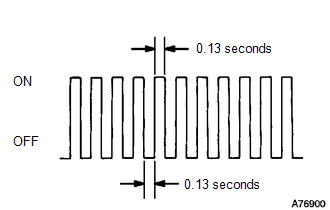CHECK MODE PROCEDURE HINT: Compared to normal mode, check mode is more sensitive to malfunctions. Therefore, check mode can detect the malfunctions that cannot be detected in normal mode. NOTICE: All the stored DTCs and freeze frame data are cleared if: 1) the ECM is changed from normal mode to check mode or vice versa; or 2) the ignition switch is turned from ON to ACC or off while in check mode. Before changing modes, always check and note any DTCs and freeze frame data. 1. CHECK MODE PROCEDURE (a) Check and ensure the following condition: (1) Battery positive voltage 11 V or more. (2) Throttle valve fully closed. (3) Shift lever in P or N. (4) A/C switch OFF. (b) Turn the ignition switch off. (c) Connect the Techstream to the DLC3. (d) Turn the ignition switch to ON. (e) Turn the Techstream on. (f) Enter the following menus: Powertrain / Engine and ECT / Utility / Check Mode. (g) Switch the ECM from normal mode to check mode. (h) Make sure the MIL flashes as shown in the illustration.  (i) Start the engine. (j) Make sure the MIL turns OFF. (k) Simulate the conditions of the malfunction described by the customer. (l) Check DTCs and freeze frame data using the Techstream. |
Toyota Tundra Service Manual > Seat: Seat Heater Control
Components COMPONENTS ILLUSTRATION Installation INSTALLATION CAUTION / NOTICE / HINT CAUTION: Wear protective gloves. Sharp areas on the parts may injure your hands. HINT: Use the same procedure for the RH and LH sides. The procedure listed below is for the LH side. PROCEDURE 1. INSTALL SEAT HEATER ...